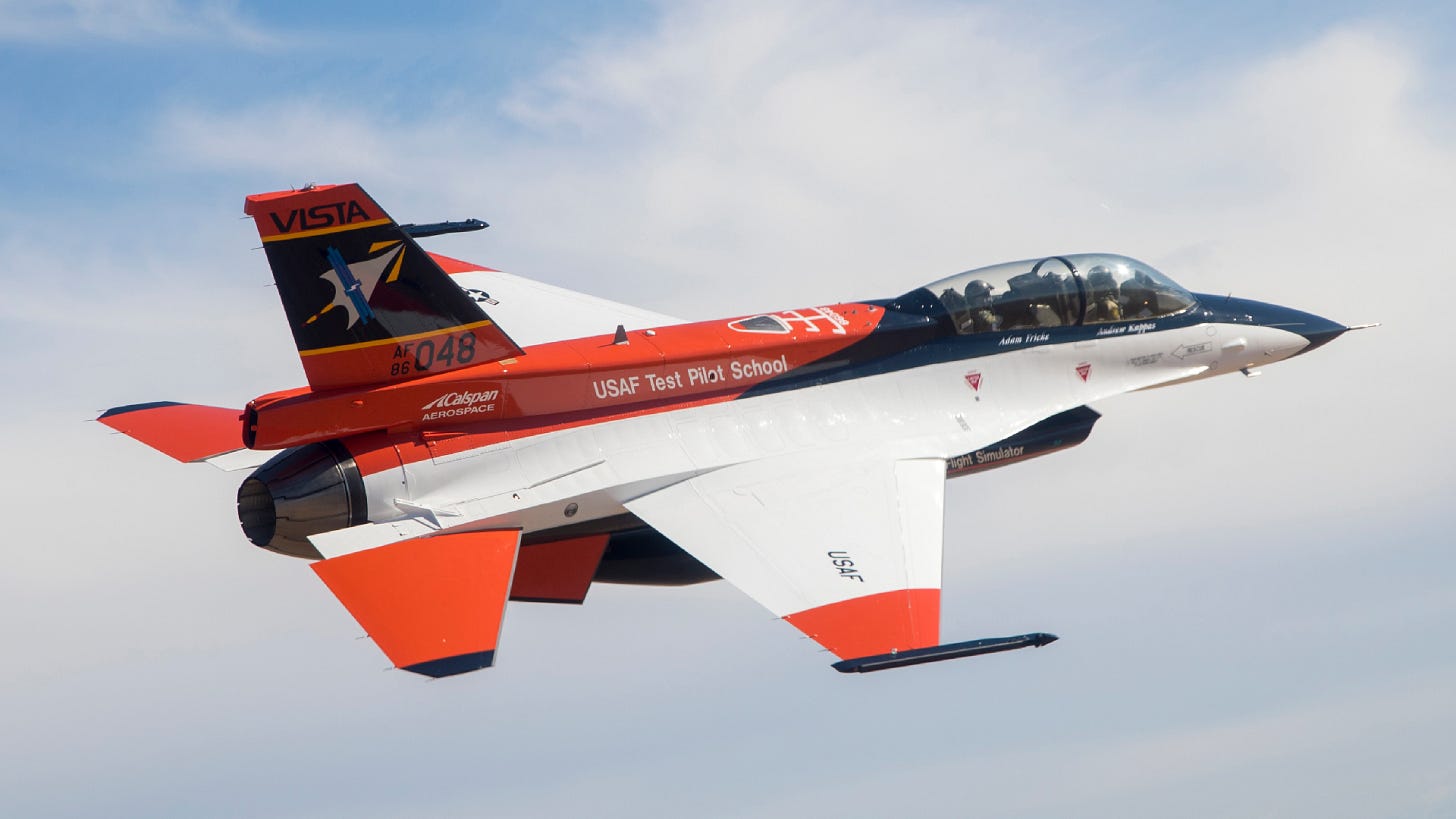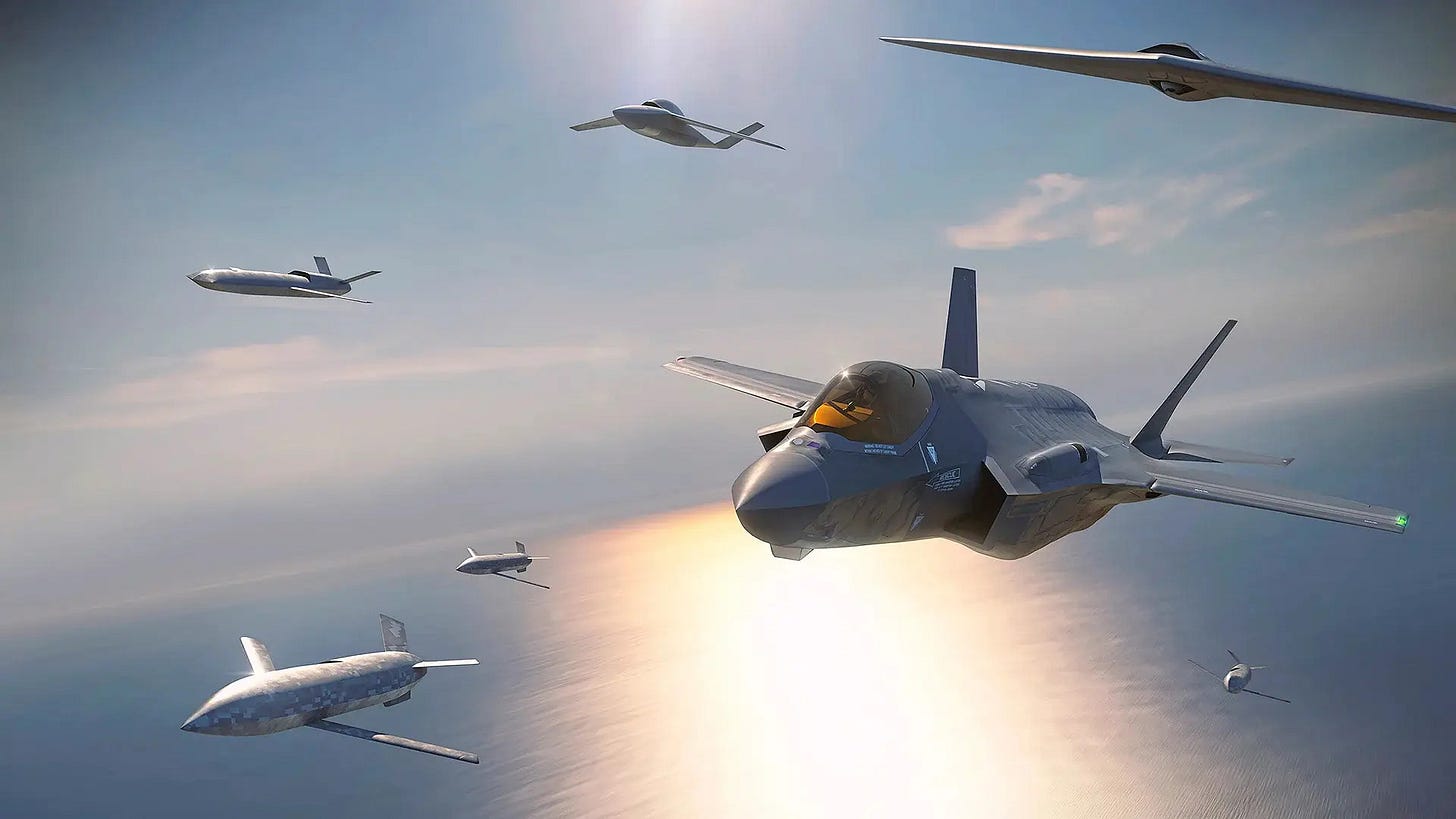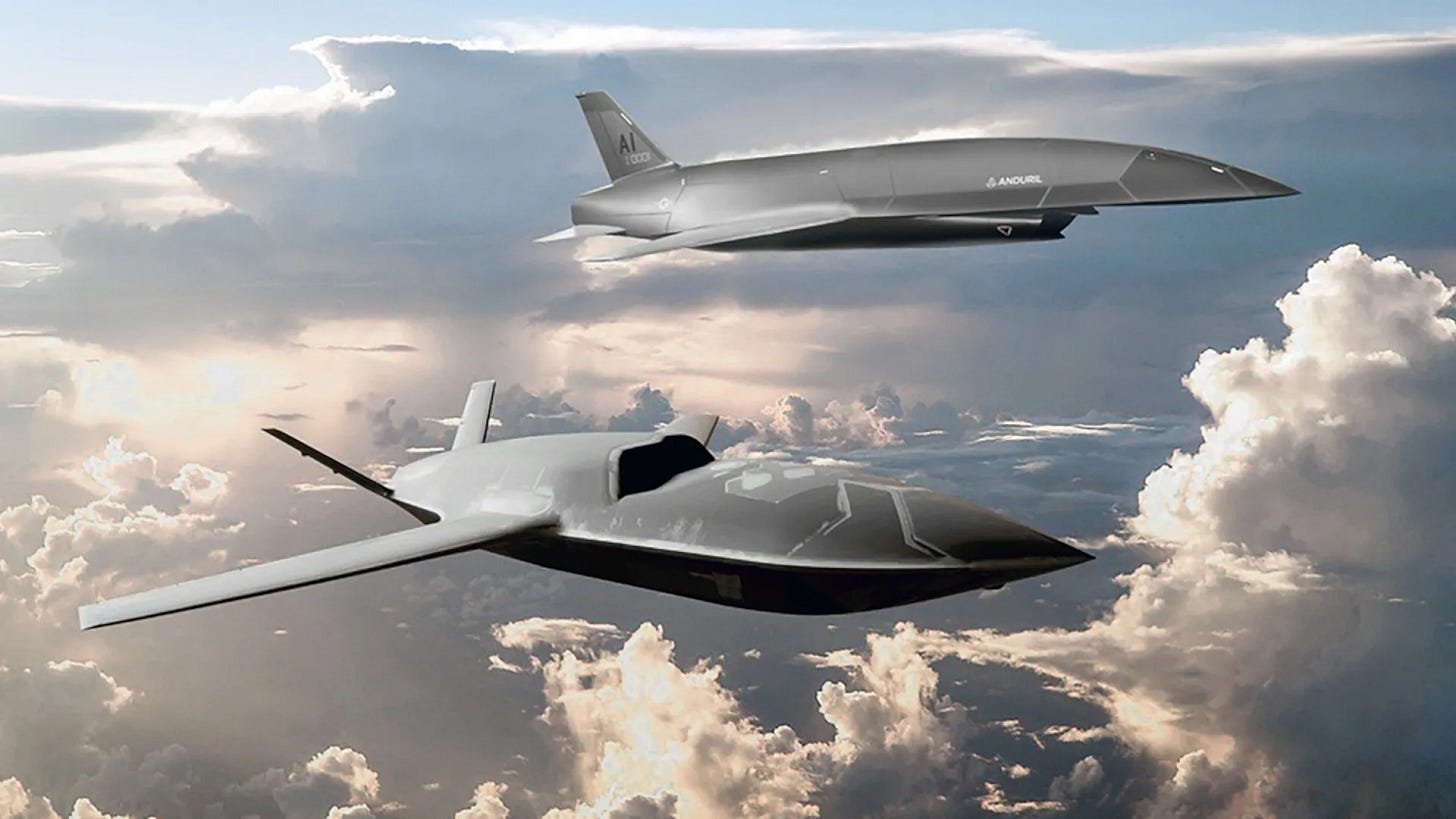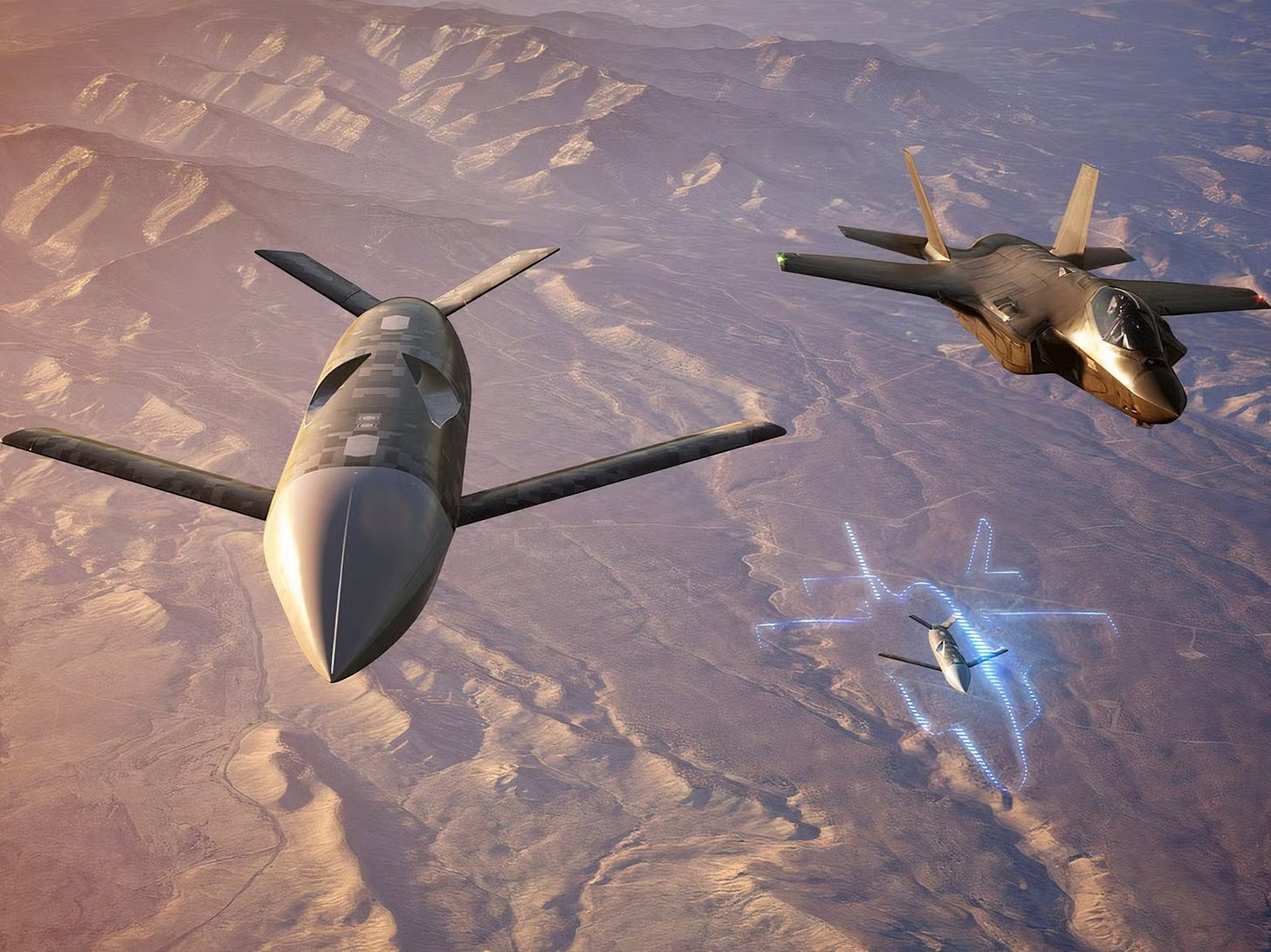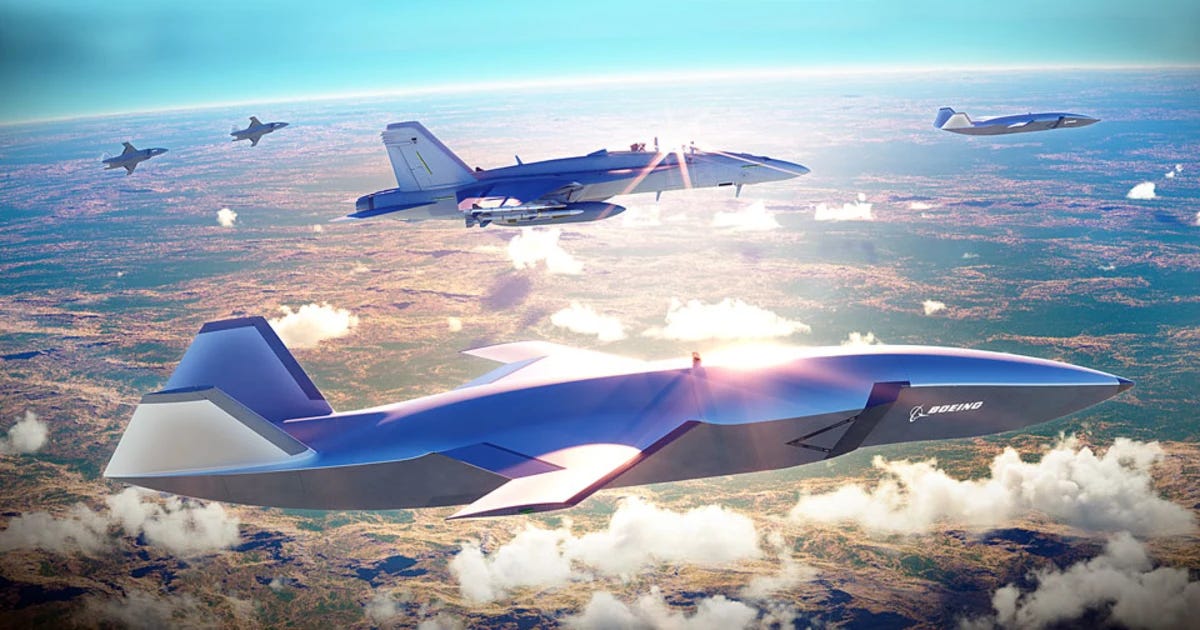The First Fighter Jets Outfitted with AI
The U.S. Air Force via the VENOM program will lead the world's air-forces into a new era via AI-driven systems in the F-16 Fighting Falcon.
The Engineer's Perspective is a reader-supported publication. Sign and up and subscribe to see more in-depth Aerospace/Aeronautical Analysis!
Introduction
The U.S. Air Force is integrating artificial intelligence (AI) into combat-coded F-16s as part of the Viper Experimentation and Next-gen Operations Model (VENOM) program. The VENOM program is designed to support the development of Collaborative Combat Aircraft (CCA) and manned-unmanned teaming (MUM-T) operations. The initiative aims to enhance the capabilities of legacy fighter jets by leveraging AI for improved decision-making and operational efficiency, with several F-16s at Eglin Air Force Base being modified for this purpose.
By transforming the F-16 into a flying testbed for advanced autonomy, the Air Force can explore new operational concepts that combine the strengths of both manned and unmanned systems.
The integration process involves a series of upgrades including the installation of advanced AI systems, sensors, and an auto-throttle system that will enable the aircraft to operate autonomously in various scenarios. By Integrating AI into F-16s, significant improvements in decision-making speed and precision can be achieved. AI systems’ ability to process vast amounts of data quickly allows for with real-time situational awareness and Obsersvation.
This enhanced situational awaress via AI allows the system to output tactical recommendations to pilots Orienting them quickly, enhancing the effectiveness of combat operations by allowing pilots to focus on strategic Decisions, with AI handling tactical Actions.
However, this integration also presents challenges.
Ensuring seamless interaction between AI systems and existing aircraft avionics is crucial to prevent technical issues that could compromise safety or performance. Additionally, addressing ethical concerns related to autonomous decision-making in combat is essential. The Air Force must ensure that AI systems operate within established legal and ethical frameworks, maintaining accountability and transparency in their decision-making processes.
The program must balance the benefits of autonomy with the need for human oversight and control, adopting a "human-on-the-loop" approach to ensure safety and accountability. This model ensures that while AI systems can execute tasks autonomously, human operators remain responsible for making strategic decisions and intervening when necessary. As the Air Force continues to develop these technologies, it is navigating the complexities of integrating AI into military operations.
This involves not only technical challenges but also strategic considerations about how AI will be used in future conflicts and how it will impact the role of human pilots in air combat. The success of the VENOM program would pave the way for more advanced autonomous systems in the future and transform the nature of air warfare.
Background on the VENOM Program
Program Overview
The VENOM program is an initiative by the U.S. Air Force to modify F-16 fighter jets for testing and developing autonomous flight and combat capabilities. This program involves modifying six F-16s to operate with AI pilots, or "agents," which have shown promising results in virtual dogfights against human pilots during DARPA's Alphadogfight trials in 2020. These trials demonstrated the AI's ability to adapt and learn from combat scenarios, often performing well in simulated engagements.
The program began in April 2024 with the arrival of the first three F-16s at Eglin Air Force Base, marking the start of a rigorous modification and testing phase. This phase will include flight trials to evaluate the AI’s performance in real-world conditions, with the goal of having the AI support pilots in complex combat environments. Successful integration of AI into these aircraft is will provide a platform for testing advanced autonomous systems that in turn can applied to future air superiority platforms.
Technical Details
The modifications under the VENOM program involve both software and hardware upgrades. While the AI and software modifications are classified, what has been shared that will be key to AI controlling the aircraft is the installation of an auto-throttle system, for the AI to control the engine's thrust. This system will allow the AI to manage the aircraft's speed and altitude, allowing for further execution of complex maneuvers without human intervention.
Additionally, these version of the F-16 are equipped with more advanced sensors, than the earlier versions of the F-16 e.g., the APG-83 Active Electronically Scanned Array (AESA) radar. The AI’s overall combat capability will be improved with the ability to access these advanced technologies will enhance by performing target detection and having access to higher-resolution images of the battlefield. Other advanced upgrades will include electronic warfare suites to support autonomous threat detection and countermeasures, further enhancing the aircraft's survivability in contested airspace.
These modifications will transform the F-16 into an experimental platform where AI can be tested under real-world flight conditions with a human pilot onboard acting as a supervisory controller. The pilot's role is crucial, as they provide oversight and intervene when necessary, ensuring that the AI operates within established safety and operational parameters. This "human-on-the-loop" approach taken by the Air Force will be used to evaluate the effectiveness of AI in combat scenarios while maintaining accountability and control.
Strategic Rationale
The VENOM program supports the development of Collaborative Combat Aircraft (CCA) and manned-unmanned teaming (MUM-T) operations. By enhancing the Air Force's capacity for autonomous decision-making, the program aims to extend combat reach and improve survivability. The CCA initiative involves deploying autonomous drones to operate alongside crewed fighter jets, enhancing mission capabilities and reducing pilot workload. These drones can perform tasks such as reconnaissance, electronic warfare, and strike missions, freeing up manned aircraft to focus on more complex tasks.
The VENOM program complements these efforts by providing a testbed for advanced autonomy, contributing to the development of future air superiority platforms. By integrating AI into legacy aircraft, the Air Force will quickly gather valuable real-time flight data and accelerate the development of these future systems, without having to develop test UAVs for this explicit purpose.
Significance
Details of AI Integration
The AI agents in the VENOM program have undergone extensive testing in complex air combat operations, including defensive maneuvers and offensive high-aspect nose-to-nose engagements against human-piloted F-16s. These tests were conducted in both simulation environments and real-world flight conditions, allowing the AI to refine its combat tactics and decision-making capabilities across thousands of iterations. The simulations include one-on-one and two-on-two dogfights, both within and beyond visual range, replicating the dynamic conditions of air combat.
Operational Impact
The integration of AI into combat-coded F-16s offers several operational benefits. It has the potential to enhance combat performance by providing pilots with real-time data and tactical recommendations, reducing the cognitive burden on pilots during high-intensity missions. This can lead to improved survivability, as AI systems can process vast amounts of data quickly, potentially preventing accidents by identifying threats earlier than human pilots. Additionally, AI can act as a 2nd pilot in the cockpit, and can optimize flight paths while managing systems simultaneously, reducing pilot workload and enhancing overall mission effectiveness.
Challenges
The integration of AI into combat aviation presents several challenges, including differences in decision-making processes between AI and human pilots.
AI Pilot Decision-Making Process
Data-Driven Decisions: AI systems rely on vast amounts of historical data and algorithms to analyze situations quickly. They can process multiple variables simultaneously, providing rapid responses that can enhance safety and efficiency. This requirement for vast amount of data necessitates extensive flight testing by the Air Force under numerous conditions and scenarios to maximize the knowledge and data accessible by AI.
Programmed Parameters: AI decision-making is limited to the parameters set by its programming and training data. This means what while AI can consistently follow safety protocols and avoid fatigue, it may struggle with unexpected scenarios outside its training scope, thereby necessitating the maximizing of test scenarios and data for the AI to use.
Continuous Support: Alongside support in direct combat AI can offer continuous support to pilots, during maneuvers by helping them evaluate their surroundings and make decisions without biasing them towards specific actions. For example, the AI could help the pilot take evasive maneuvers if it observes or detects something in sensors that the pilot may miss due to mental fatigue. This support can be particularly effective in emergencies when combined with recommendations.
Human Pilot Decision-Making Process
Experience-Based Decisions: Human pilots draw from years of personal experience and training to make holistic decisions. They can assess situations considering emotional and psychological factors that AI may not fully grasp. Examples may include predicting the actions of other pilots based on experience with particular maneuvers.
Intuition and Adaptability: Humans are trained to handle unexpected situations, often relying on intuition and experience. They can adapt quickly to new information and changing conditions, which is crucial in dynamic environments like aviation.
Emotional Intelligence: Human pilots can interpret emotional cues and stress levels, which can be critical in emergencies. However, they are susceptible to fatigue, stress, and human error, which can impact performance.
Key Differences
Speed and Data Processing: AI can analyze data faster and more accurately than humans, but it lacks the adaptability and emotional intelligence of human pilots.
Decision-Making Style: AI tends to follow a structured, algorithmic approach, while humans use a combination of experience, intuition, and situational awareness.
Role in Aviation: AI is increasingly seen as a co-pilot, providing support and enhancing human precision, rather than replacing human pilots entirely.
Overall, AI and human pilots complement each other, with AI offering speed and consistency, and humans providing adaptability and emotional intelligence. The integration of AI into aviation aims to leverage these strengths to enhance safety and efficiency, maximizing the strengths of each capability while minimizing the other’s weaknesses.
Future Outlook and Implications
Path to Operational Capability
The VENOM program is expected to lead the U.S. Air Force into a new era of air combat development by integrating AI-driven systems into existing platforms like the F-16 Fighting Falcon. This initiative represents a critical step in advancing autonomous flight capabilities, with AI systems being rigorously tested in simulations and real-world conditions. The program’s systematic approach has used faster-than-real-time simulations, hardware-in-the-loop testing, and ground testing before finally advancing to live flight trials. These steps are to ensure that AI systems can interact safely and effectively with the aircraft’s avionics and flight control systems, minimizing risks during autonomous operations.
The arrival of the final modified F-16 at Eglin Air Force Base in April 2025 signifies the completion of the fleet designated for VENOM testing. With all six aircraft now ready for modification and experimentation, the program is positioned to accelerate the development of AI technologies for both crewed and uncrewed platforms. The VENOM-AFT (Autonomy Flying Testbed) system is designed to refine AI decision-making models and autonomous flight capabilities, ultimately supporting the Air Force’s broader goals of enhancing operational efficiency and reducing pilot workload.
Strategic Impact
The integration of AI into F-16s sets a precedent for future autonomous systems, potentially transforming air combat paradigms and enhancing U.S. air superiority capabilities. VENOM directly supports the Collaborative Combat Aircraft (CCA) initiative, which envisions unmanned systems operating alongside manned fighters in coordinated missions. These autonomous drones could perform roles such as reconnaissance, electronic warfare, and precision strikes, complementing crewed platforms by extending mission reach and reducing risks to human pilots.
VENOM’s focus on manned-unmanned teaming (MUM-T) operations highlights its strategic importance in modernizing air combat tactics. By enabling seamless collaboration between AI-driven systems and human pilots, the program aims to improve decision-making speed, situational awareness, and overall mission effectiveness. This approach aligns with broader efforts to develop next-generation platforms like the Next-Generation Air Dominance (NGAD) fighter, which will incorporate advanced autonomy as a core feature.
Beyond tactical applications, VENOM’s advancements have implications for long-term military strategy. The ability to deploy autonomous systems alongside traditional crewed aircraft enhances flexibility in responding to emerging threats and reduces reliance on human operators in high-risk scenarios. As AI technologies mature through programs like VENOM, they are expected to play a key role in maintaining U.S. air superiority by adapting to evolving combat environments and technological challenges.
Challenges Ahead
Despite its promise, VENOM faces several challenges on its path to operational capability. Ensuring that AI systems operate within safety envelopes is critical for minimizing risks during autonomous missions. Engineers must validate that autonomous commands do not exceed aircraft limits or compromise pilot safety during aggressive maneuvers. Additionally, ethical considerations surrounding autonomous decision-making in combat must be addressed, particularly regarding accountability for actions taken by AI systems.
As VENOM progresses toward live flight testing, these challenges will need to be carefully managed to ensure that AI integration enhances rather than complicates air combat operations. The program’s success will not only impact current platforms but also shape the development of future autonomous systems across the U.S. military.
Conclusion
The integration of AI into F-16s under the VENOM program represents a notable advancement in autonomous flight capabilities. By transforming legacy aircraft into testbeds for AI systems, the program demonstrates potential combat capability, operational efficiency, and survivability. he modifications to support AI, such as auto-throttle systems and advanced sensors, will enable these aircraft to operate autonomously in various combat scenarios in support of the Air Force’s initiative to modernize its fleet and explore new possibilities in aerial warfare.
This development has significant implications for the future of air combat, for the VENOM program will not only enhance the capabilities of existing platforms but also lays the groundwork for next-generation systems like Collaborative Combat Aircraft (CCA) and Manned-Unmanned Teaming (MUM-T) operations. These initiatives aim to integrate autonomous drones and AI-driven systems alongside human-piloted aircraft, creating a more flexible and effective combat force. Such advancements could redefine air combat strategies, enable faster decision-making and reduce pilot workload.
While the VENOM program marks progress, it also highlights challenges that must be addressed as AI technology continues to evolve. Ensuring safe integration with existing systems, refining decision-making algorithms, and addressing ethical concerns surrounding autonomous operations are critical steps for future development. As testing progresses toward live flight trials later this year, these efforts will shape how AI is deployed in military aviation.
A strategic investment in the future of aerial warfare, the VENOM program aims to bridge the gap between legacy systems and emerging technologies by positioning the U.S. Air Force to maintain its competitive edge in an increasingly complex global defense landscape. This initiative not only strengthens current capabilities but also sets a precedent for integrating AI into military operations, potentially revolutionizing air combat paradigms for decades to come.
References
Articles, News, and Analysis
U.S. Air Force Advances VENOM Programme to Test Autonomous Capabilities on Modified F-16s
F-16s Get Smarter: US Air Force Pushes AI into Combat Aviation
US Air Force VENOM Autonomy Program On Track for Flight This Year
Exclusive: US Air Force Advances VENOM F-16 Fighter Jet Program
Autonomous F-16 Program Advances with Modifications, Simulations
Let’s Forget the Hype and Talk About the AI vs. Human Pilot Simulated Dogfight
The USAF's Project VENOM is Turning Old F-16s into Drone Wingmen
AI Co-Pilot Enhances Human Precision, Enables Safer Aviation
PDFs
Videos
The Engineer's Perspective is a reader-supported publication. To receive new posts and support my work, consider becoming a free or paid subscriber.




